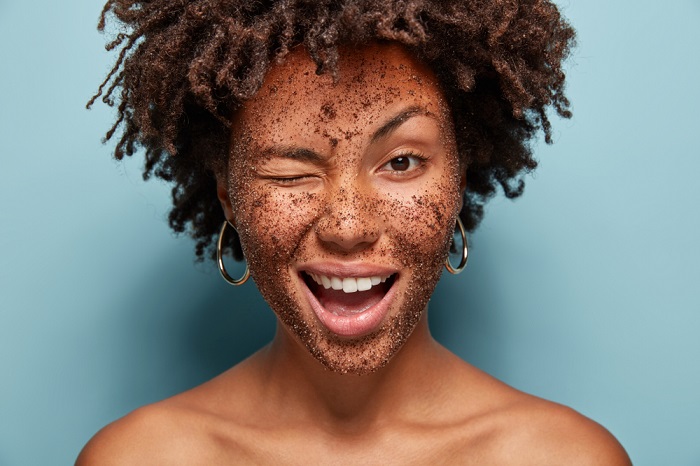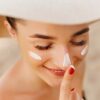
Have you ever exfoliated your face and exalted in the fresh tingle you get afterward? Exfoliating your skin removes dead skin cells and other debris from the surface, leaving your skin clean and refreshed. But, exfoliating too often can be harmful to your skin, whether you’re using a physical or chemical exfoliator.
So, how often should you exfoliate your face to strike the right balance between bright and irritated skin?
Unfortunately, there isn’t a set frequency that works for all faces. Depending on your skin type, the answer may be as little as once a week or as often as three times per week. Let’s dive in.
Exfoliating 101: The Basics
Did you know that your skin sheds over 500 million cells per day?1 Many of those cells can get left behind on your face, leading to a dull appearance and even breakouts from clogged pores.
To avoid a loss in shine, you can exfoliate—the process of removing these dead cells to leave behind a smooth surface. If your skin is prone to redness or dryness, opt to exfoliate no more than once a week. However, if you have normal, combination, or oily skin, you can benefit from exfoliating a few times a week.
Types of Exfoliants
There are two types of exfoliating products you can use:
- Chemical – Chemical exfoliants such as serums, peels, and gels often contain alpha-hydroxy acids or beta hydroxy acids.2 When applied to your face, chemical exfoliants penetrate the skin to dissolve dead cells.
- Physical – Physical exfoliants are harsher than their chemical cousins because they require scrubbing or rubbing to be effective. Scrubs, pumice, brushes, and other products that can remove the surface layer of cells are physical exfoliants. Many of these are too abrasive to use safely on your face.
Ultimately, your skin type plays a role in determining how to exfoliate your face. It also dictates how your skin responds to exfoliation. For example, dry or sensitive skin is more prone to irritation and may not benefit from exfoliation as much as oily or normal skin. But whether using a physical exfoliant or a chemical exfoliant, when done safely, the process evens out the skin tone and promotes radiant, healthy skin.
How to Exfoliate Your Face Safely
The biggest concern isn’t necessarily how often should I exfoliate my face—instead you should focus on exfoliating properly. Proper exfoliating can help brighten your skin. However, you can go overboard. Over exfoliating can damage your skin and exacerbate some of the problems you want it to solve.
If you think you’re exfoliating wrong, The American Academy of Dermatology suggests the following steps to ensure that your exfoliation efforts are beneficial to your skin.3
Step #1: Choose the Right Product for Your Skin
Individuals with sensitive or very dry skin should avoid using harsh exfoliants. These products can actually make skin irritation worse, rather than help improve tone and texture. When shopping for exfoliating products, consider the following:
- Do any of the products you already use have exfoliating properties?
- Does your skin react negatively to certain ingredients?
- Are you prone to red or blotchy skin?
- Do you take any medications containing retinol or benzoyl peroxide?
A quick check of your current skincare lineup is a must. Adding a new exfoliant when your cleanser or moisturizer already has an exfoliating ingredient can lead to:
- Skin irritation
- Redness
- Dry, flaking skin
- Breakouts
Finally, it’s always wise to start slowly. Try using the product just once per week and wait to see how your skin responds before upping your usage.
Whether it’s a product with alpha hydroxy acid, glycolic acid, beta hydroxy acid, or a scrub, it might take some trial and error to find your product. But don’t feel overwhelmed, it only means that you’re finding what works best for your unique skin.
Step #2: Use Your Exfoliating Product Gently
Exfoliating products don’t require a significant amount of muscle to work. Nor do you need to use an excessive amount of exfoliator for it to do its job, especially when using physical exfoliators. Instead, you should always strive for a gentle approach that won’t leave your skin raw and red.
To properly apply an exfoliating product, you should:3
- Use a small amount of product
- Massage gels and serums gently into your skin
- Rinse scrubs and cleansers with warm, not hot, water
- Avoid abrasive scrubbing mechanisms
You want the exfoliator to safely eliminate the dead cells, not remove the healthy ones. After you’ve finished with the exfoliation process, there’s one remaining step you should never skip—moisturize.
Step #3: Follow with a Moisturizer
One step that people often forget when they use an exfoliator is to moisturize after. Exfoliating removes all of those pesky, dead skin cells from your face’s surface. This leaves you with a nice, clean slate to apply your moisturizer. It also allows your moisturizer to work more effectively since there isn’t anything preventing the product from absorbing into your skin.
Exfoliation can strip away your skin’s natural oils, leaving behind a dry, parched face. An effective moisturizer is also crucial because it replaces needed hydration for your thirsty skin.
As such, you should moisturize immediately after exfoliating for the best results and look for a moisturizer that contains one of the following:
- Glycerin
- Hyaluronic acid
- Shea butter
So, while regular exfoliation can prevent dull skin and dead skin buildup in your pores and on your face, the way you exfoliate is just as important. Finding the right exfoliant for your skin type and protecting the skin with a moisturizer after will also make the process more effective. Following these simple steps will ensure you’re exfoliating safely.
Find Your New Favorite Skincare Products with FabFitFun
Exfoliating can be beneficial for your face — as long as you don’t go overboard. A gentle exfoliator will help remove dead skin cells and may give your skin a fresher, brighter appearance. However, you should be choosy about your exfoliating products. Avoid harsh chemicals and rough, abrasive scrubs. Don’t forget, you should exfoliate your body as well. The skin on your body should also be exfoliated safely, so look for the best face and body scrubs or chemical exfoliants for healthy skin all around.
If you’re in search of high-quality skincare products that will help keep your skin looking its best, check out FabFitFun. Our membership boxes introduce you to new, full-sized products from brands we know you’ll love. Sign up for a membership today and enjoy top-quality products from top brands.
Sources:
- American Chemical Society. The Skinny on How Shed Skin Reduces Indoor Air Pollution. https://www.acs.org/content/acs/en/pressroom/newsreleases/2011/may/the-skinny-on-how-shed-skin-reduces-indoor-air-pollution.html
- PubMed. Skin Resurfacing Chemical Peels. https://pubmed.ncbi.nlm.nih.gov/31613532/
- American Academy of Dermatology Association. How to Safely Exfoliate at Home. https://www.aad.org/public/everyday-care/skin-care-secrets/routine/safely-exfoliate-at-home




